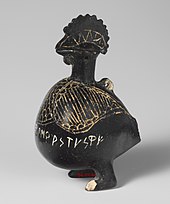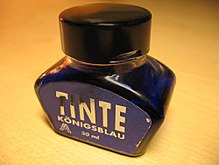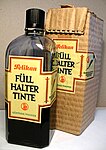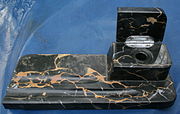Inkwell
An inkwell (also known as an ink horn ) is a container for storing ink for the preparation of handwriting with a pen . For centuries, until the invention of the fountain pen, the inkwell was an indispensable utensil for handwritten messages. After being supplanted by other writing techniques, inkwell collecting became fashionable towards the end of the 20th century. The most sought-after collectibles date from the American and French Revolutions to the 1930s.
history
Beginnings
description

Certainly the ink was invented before the inkwell, in the form of an ink made of soot , gum arabic and water by the Chinese and Egyptians around 2600 BC. The ink, the so-called iron gall ink, which is light and air-resistant on papyrus and parchment, has been around since the 3rd century BC. BC Iron gall consisted of the brew of boiled gall apples to which iron vitriol was added. Old ink drawings are often recognizable on the back of the sheet, as iron vitriol decomposes the paper.
The beginnings of the inkwell are in the dark. The first simple and unadorned inkwells , such as cattle horns for ink horns , only had the task of storing the ink and keeping it in a liquid state for as long as possible. Ornate bronze specimens have been preserved from Roman antiquity . In the late Middle Ages , successful merchants and craftsmen began to make the inkwell their status symbol .
middle Ages
The inkwell gradually became a table-top writing instrument, which could consist of carved and richly decorated cassettes, box-shaped containers and the corresponding vessels for ink and writing utensils. As with many everyday objects, the inkwells reflected the trends, tastes, zeitgeist and culture of the people who designed and manufactured them.
Simple silver writing materials have been around since the end of the 15th century. Magnificently ornamented inkware appeared in the 16th century.
Modern times
Artisans such as silversmiths , potters , metalworkers and cabinet makers created an inkwell boom at the beginning of the 18th century. The silversmiths, who until then were mainly known for their artfully crafted tablets and candlesticks, combined their products with intricately shaped and chiseled inkwells, writing sets and sand spreaders. In the north-west of the United States of America, more than 70 inkwell manufacturers were established at the end of the 18th century . At that time, several hundred companies were producing around the world.
The ink used to sign the US Declaration of Independence was in a real sterling silver inkwell , while Abraham Lincoln's desk was adorned with an inkwell carved from wood.
The wedding of the inkwells: the 19th century
However, the "golden age" of the inkwell did not begin until the late Victorian era , that is, in the second half of the 19th century. Here the ornate silver writing utensils dominated on a silver tray made of pure Sheffield silver. Admiral Lord Nelson , for example, made it very important to always carry his Sheffield Plate with him when traveling by sea and land. Court ladies and mistresses also posted ensembles of ink pots on their dressing tables.
Travel ink pots with secure closures to prevent the ink from leaking into bags and suitcases were used particularly by traveling salesmen in the 18th and 19th centuries.
The inkwells began to disappear from the market with the innovation of the fountain pen in 1884. The invention of the ballpoint pen in 1932 marked the final decline of the inkwell. But in the 1950s, primary school students were still sitting at school desks that had a porcelain inkwell in an opening on the front edge.
The inkwells used today are actually ink bottles. Most of them are simple, undecorated sales containers made by ink manufacturers made of glass or plastic. Some luxury goods manufacturers like Montblanc still make proper inkwells for the desk. However, these are primarily of a decorative nature and are only used to refill the fountain pen occasionally.
Today school fountain pens only use ink cartridges .
gallery
Luxurious writing utensils made from Ludwigsburg porcelain , around 1765
Inkwell with the well-known Pelikan 4001 ink and piston fountain pen
Inkwell with writing tray made of Nero Portoro
Writing set, combined pen tray with an inkwell holder and a dog as decoration, in the inventory of the MEK
Trivia
- The Munzenberg Castle is also known as the Wetterau Inkwell in the region because its silhouette with the two towers is reminiscent of a two-part inkwell, as it was in use from the 18th century (the second "barrel" took up the sand that was used before the Blotting paper was used).
literature
- The picture poem The story of the black boys in Heinrich Hoffmann's Struwwelpeter set a literary and iconographic monument to the inkwell . In this parable , St. Nicholas appears as the punitive authority who puts little boys in an inkwell for mocking a dark-skinned boy.
- A Middle Low German petition from Bielefeld (approx. 1496) is about a schoolboy who fatally injured a schoolmate in a dispute over an inkwell ('enkethorn'). (cf. Eichhorn or Inkwell? by Meinolf Schumacher )
- In Hans Christian Andersen's fairy tale about the quarrel between the pen and the inkwell , the question of the origin of the hen or the egg is varied.
- The periodical " Das Inkfass " has been published by the Zurich paperback publisher Diogenes since 1965, first as an in-house journal, then as a publishing almanac. From 1997 it is published annually on the occasion of the Frankfurt Book Fair .
- Claus Maywald, The Ink Bottle, FU-Berlin History, PhD thesis on microfiche, Berlin 1998.
Individual evidence
Web links
- Old inkwells
- The Vergennes inkwell ( memento of September 6, 2003 in the Internet Archive ) in the Quai d'Orsay










